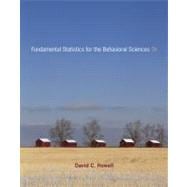David Howell's practical approach focuses on the context of statistics in behavioral research, with an emphasis on looking before leaping; investigating the data before jumping into a test. This provides you with an understanding of the logic behind the statistics: why and how certain methods are used rather than just doing techniques by rote.
Formulas used in the book are definitional rather than for purposes of calculation, as Howell believes formulas are there to help students define the concepts. This textbook offers hundreds of exercises, most of which are based on data from published research, promote student interest and provide the context of statistics in behavioral research.
Learn faster and understand more because Howell's texts moves you beyond number crunching, allowing you to discover the meaning of statistical results and how they relate to the research questions being asked.








